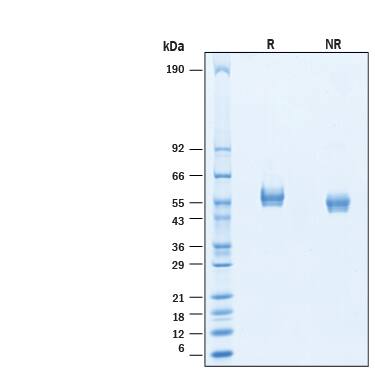CD4: Proteins and Enzymes
CD4 is a transmembrane glycoprotein that is expressed predominantly on thymocytes and a subset of mature T lymphocytes. It is a standard phenotype marker for the identification of T cell populations. CD4 is expressed along with CD8 on double positive T cells during their development in the thymus. Either CD4 or CD8 expression is then lost, givin...
15 results for "CD4 Proteins and Enzymes" in Products
15 results for "CD4 Proteins and Enzymes" in Products
CD4: Proteins and Enzymes
CD4 is a transmembrane glycoprotein that is expressed predominantly on thymocytes and a subset of mature T lymphocytes. It is a standard phenotype marker for the identification of T cell populations. CD4 is expressed along with CD8 on double positive T cells during their development in the thymus. Either CD4 or CD8 expression is then lost, givin...
| Source: | Sf 21 (baculovirus) |
| Accession #: | P01730.1 |
| Applications: | BA |
| Source: | CHO |
| Accession #: | P01730.1 |
| Applications: | BA |
| Source: | CHO |
| Accession #: | P79185.1 |
| Applications: | BA |
| Source: | NS0 |
| Accession #: | P06332.1 |
| Applications: | BA |
| Source: | CHO |
| Accession #: | P79185.1 |
| Applications: | BA |
Biotinylated
| Source: | CHO |
| Accession #: | P01730.1 |
| Applications: | BA |
| Source: | CHO |
| Accession #: | P01730.1 |
| Applications: | BA |
| Source: | NS0 |
| Accession #: | NP_001009250 |
| Applications: | BA |
| Source: | NS0 |
| Accession #: | P05540 |
| Applications: | BA |
| Source: | NS0 |
| Applications: | BA |
| Source: | NS0 |
| Accession #: | P33705 |
| Applications: | AC |
| Applications: | PAGE |
| Applications: | AC |
| Applications: | AC |









![SDS-PAGE: Recombinant Human CD4 His Protein [NBP2-50553] SDS-PAGE: Recombinant Human CD4 His Protein [NBP2-50553]](https://resources.bio-techne.com/images/products/Recombinant-Human-CD4-Protein-SDS-Page-NBP2-50553-img0001.jpg)